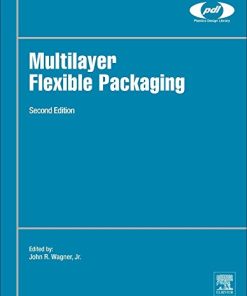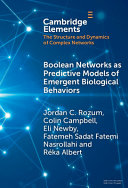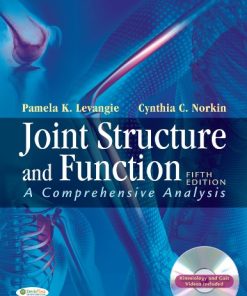(EBook PDF) Multilayer Networks Structure and Function 1st edition by Ginestra Bianconi 0191068500 9780191068508 full chapters
$50.00 Original price was: $50.00.$25.00Current price is: $25.00.
Multilayer Networks: Structure and Function 1st edition by Ginestra Bianconi – Ebook PDF Instant Download/DeliveryISBN: 0191068500, 9780191068508
Full download Multilayer Networks: Structure and Function 1st edition after payment

Product details:
ISBN-10 : 0191068500
ISBN-13 : 9780191068508
Author: Ginestra Bianconi
Multilayer networks is a rising topic in Network Science which characterizes the structure and the function of complex systems formed by several interacting networks. Multilayer networks research has been propelled forward by the wide realm of applications in social, biological and infrastructure networks and the large availability of network data, as well as by the significance of recent results, which have produced important advances in this rapidly growing field. This book presents a comprehensive account of this emerging field. It provides a theoretical introduction to the main results of multilayer network science.
Multilayer Networks: Structure and Function 1st Table of contents:
Part I. Single and Multilayer Networks
1. Complex Systems as Multilayer Networks
1.1 What are multilayer networks?
1.2 Information gain in multilayer networks
1.3 Overview of dynamical processes on multilayer networks
Part II. Single Networks
2. The Structure of Single Networks
2.1 Networks
2.2 Single network types
2.3 Basic definitions
2.3.1 Nodes and links
2.3.2 Adjacency matrix and incidence matrix
2.3.3 Degree, degree sequence and degree distribution
Degree
Degree Sequence and Average Degree
Degree distribution
2.3.4 Clustering coefficient
2.3.5 Shortest distance and diameter
2.3.6 Connected components and giant component
2.4 Universalities
2.4.1 Complex networks
2.4.2 Small-world networks
2.4.3 Scale-free networks
2.5 Structural correlations
2.5.1 General remarks
2.5.2 Degree correlations
2.5.3 Strength and inverse participation ratio
2.6 Communities
2.6.1 Communities in complex networks
2.6.2 Hierarchical clustering
2.6.3 Modularity
2.6.4 Fast community detection algorithms
2.6.5 Overlapping communities
2.7 Centralities
2.7.1 General remarks
2.7.2 Eigenvector centrality
2.7.3 Katz centrality
2.7.4 PageRank centrality
2.7.5 Closeness and efficiency
2.7.6 Betweenness centrality
2.7.7 Communicability
2.8 Models for complex networks
2.8.1 The relevance of modelling complex networks
2.8.2 Random graphs
2.8.3 Small-world network models
2.8.4 Growing network models
The emergence of the scale-free property
The Barabási–Albert model
Non-linear preferential attachment
Growing network models enforcing triadic closure
2.8.5 Ensemble of networks
Maximum entropy ensembles
Canonical network ensembles with expected degree sequence
Microcanonical network ensemble with given degree sequence
Uncorrelated networks
Block models
2.9 Spatial network ensembles
3. The Dynamics on Single Networks
3.1 Interplay between structure and function
3.2 Phase transitions and emergent phenomena
3.3 Robustness and percolation
3.3.1 The percolation transition
3.3.2 Node percolation
Message-passing approach
Percolation in Poisson networks
Percolation in scale-free networks
3.3.3 Bond percolation
3.3.4 Targeted attack
3.4 Epidemic spreading
3.4.1 The relevance of epidemic spreading
3.4.2 SIS and SIR models
3.4.3 Phase transitions in epidemic spreading
3.4.4 SIS model
3.4.5 SIR model
3.4.6 Immunization strategies
3.5 Diffusion and random walks
3.5.1 Diffusion
3.5.2 Random walk
3.6 Synchronization
3.6.1 Master Stability Function
3.6.2 The Kuramoto model
3.7 Network control
Part III. Multilayer Networks
4. Multilayer Networks in Nature, Society and Infrastructures
4.1 Multilayer networks: the general multidisciplinary framework
4.2 Multilayer networks: a gentle introduction
4.3 Social networks
4.3.1 Online social networks
4.3.2 Collaboration and citation networks
4.3.3 Temporal social networks
4.4 Complex infrastructures
4.4.1 Transportation networks
4.4.2 Interconnected infrastructures
4.5 Economical and financial networks
4.5.1 Trade multiplex networks
4.5.2 Financial multiplex networks
4.6 Molecular networks and the interactome
4.7 Brain networks
4.8 Ecological networks
4.9 Climate networks
5. The Mathematical Definition
5.1 General multilayer networks and more specific topologies
5.2 The most general multilayer network
5.3 Multiplex networks
5.3.1 General properties
5.3.2 Multiplex networks without interlinks
5.3.3 Multiplex networks with interlinks
5.3.4 Multiplex edge list and multiplex data
5.3.5 Aggregated network
5.4 Multi-slice networks
5.4.1 General properties
5.4.2 Multi-slice networks without interlinks
5.4.3 Multi-slice networks with interlinks
5.4.4 Multi-slice edge list
5.4.5 Aggregated network
5.5 Other types of multilayer network
5.5.1 Formalism
5.5.2 Replica nodes
5.5.3 Networks of networks
5.5.4 Multilayer edge list
5.6 Tensorial formalism for multilayer networks
6. Basic Structural Properties
6.1 The effect of multiplexity on network structure
6.2 Degree
6.2.1 Multiplex degree
6.2.2 Degree distributions of multiplex and multi-slice networks
6.2.3 Aggregated degree and aggregated strength
6.2.4 Multilayer degree
6.2.5 Multilayer degree distributions
6.3 Clustering coefficient
6.3.1 General remarks and definitions for multiplex networks
6.3.2 Parametrized clustering coefficient in multiplex networks
6.3.3 Cross-clustering coefficient in general multilayer networks
6.4 Distance-dependent measures
6.4.1 Interdependence of a multiplex network
6.4.2 Distance properties of general multilayer networks
7. Structural Correlations of Multiplex Networks
7.1 Correlations in multiplex networks
7.2 Interlayer degree correlations in multiplex networks
7.2.1 Other measures to evaluate the heterogeneity of the degrees of the nodes
7.3 Overlap, multilinks and multidegrees
7.3.1 Overlap
7.3.2 Multilinks and multidegrees
7.3.3 Multidegree distribution
7.4 Correlations in weighted multiplex networks
7.5 The activities of the nodes and pairwise multiplexity
8. Communities
8.1 The relevance of communities in multilayer networks
8.2 Multilayer community detection
8.2.1 Community detection algorithms using a generalized modularity measure
8.2.2 Consensus clustering
8.2.3 Detecting mesoscale structure using random walks
8.2.4 Multilink community detection
8.2.5 Detecting mesoscale organization using tensor computation
8.3 Correlations in the community structure of multiplex networks
8.3.1 Normalized Mutual Information
8.3.2 Similarity index based on information theory
8.4 To aggregate or to disaggregate?
8.4.1 Reducibility of multilayer networks
8.4.2 Revealing the hidden multilayer structure of single networks
8.4.3 Assessing the multiplex nature of communities
9. Centrality Measures
9.1 Centrality measures and multiplexity
9.2 Multiplex PageRank
9.3 Multiplex Eigenvector Centralities
9.4 Functional Multiplex PageRank
9.4.1 A function as centrality measure
9.4.2 Definition
9.4.3 Correlations between the Functional Multiplex PageRank of different nodes
9.4.4 Absolute Functional Multiplex PageRank
9.4.5 Application to duplex networks
9.5 MultiRank
9.5.1 Ranking nodes and layers
9.5.2 The definition
9.5.3 Possible variations of the MultiRank algorithm
9.5.4 Applications to real datasets
9.6 Versatility
9.7 Multilayer Communicability
9.8 Centrality of multi-slice networks
10. Multilayer Network Models
10.1 Different approaches to multilayer network modelling
10.2 Growing multiplex network models
10.2.1 Growing multiplex networks
10.2.2 Generalized linear preferential attachment model
10.2.3 Generalized non-linear preferential attachment
10.2.4 Growing multiplex networks with communities
10.2.5 Other attachment kernels
10.3 Multiplex network ensembles
10.3.1 Ensembles as null models of networks
10.3.2 The theoretical framework
10.3.3 Ensembles with independent layers
Independent layers and correlated degrees
Canonical multiplex network ensemble
Microcanonical ensemble
10.3.4 Independent layers do not display significant overlap
10.3.5 Multiplex networks with given multidegree sequence or expected multidegree sequence
Ensemble with dependent layers
Canonical ensemble
Construction of the canonical ensemble with expected multidegree sequence
Microcanonical ensemble
Construction of microcanonical multiplex ensemble with given multidegree sequence
10.3.6 Spatial multiplex network ensembles
10.3.7 Multiplex networks with heterogeneous activity of the nodes
10.4 Randomization algorithms
Randomization of the replica nodes
Independent randomization of each layer
Randomization algorithm preserving the multidegree sequence
10.5 Models of multi-slice temporal networks
10.5.1 Modelling temporal networks
10.5.2 Models with temporal activity of the nodes
Temporal activity model: the motivation
Definition
Derivation of the aggregated degree distribution
Variations of the model
10.5.3 Exponential random multi-slice networks
10.5.4 Models with burstiness
Burstiness in temporal networks
Bursty model for face-to-face interactions
Model for mobile-phone interactions
10.6 Ensembles of more general multilayer networks
Networks of networks with replica nodes
Networks of networks without replica nodes
Multilayer networks with replica nodes and with given supradegree distribution
Multilayer networks with multiple interconnections
11. Interdependent Multilayer Networks
11.1 Interdependencies in multilayer networks
11.2 Percolation of interdependent networks
11.2.1 The Mutually Connected Giant Component of a multiplex network
11.2.2 Hybrid phase transition and avalanches of failure events
11.3 Interdependent multiplex networks without link overlap
11.3.1 The message-passing algorithm
Given network and initially damaged nodes
Given network and random damage of the nodes
Random network and random damage of the nodes
11.3.2 Cascading failures
11.3.3 Case of a multiplex formed by M Poisson networks with the same average degree
11.3.4 Case of a duplex network formed by two Poissonnet works with different average degree
11.3.5 Multiplex networks formed by layers of scale-free networks
11.3.6 Percolation in networks with degree correlations
11.3.7 Percolation in spatial multiplex networks
11.4 Interdependent multiplex networks with link overlap
11.4.1 The effect of link overlap on percolation
11.4.2 Message-passing algorithms
11.5 Partial and redundant interdependencies
11.5.1 Partial interdependence
11.5.2 Redundant interdependencies
Redundant interdependencies: the motivation
Redundant Mutually Connected Giant Components
Message-passing equations determining the RMCGC
Comparison between the RMCGC and the MCGC
11.6 Percolation on interdependent multilayer networks
Networks of networks with replica nodes
Multilayer networks without replica nodes and with given supradegree distribution
Networks of networks without replica nodes
12. Classical Percolation, GeneralizedPercolation and Cascades
12.1 Robustness of multilayer networks
12.2 Classical percolation
12.2.1 Classical percolation: general remarks
12.2.2 Classical percolation in multiplex networks
The message-passing algorithm
Ensemble of multiplex networks without link ovelap
Ensembles of multiplex networks with link overlap
12.2.3 Classical percolation in multilayer networks
The message-passing algorithm
Ensemble of multilayer networks
The case of a multilayer network ensemble with M = 2 layers
Effect of interdegree and intradegree correlations
12.3 Directed percolation
12.3.1 Directed mutually connected components
12.3.2 The message-passing algorithm
12.4 Antagonist percolation
12.5 Cascades on multilayer networks
12.5.1 Cascades without interdependencies
12.5.2 Cascade of loads and sandpile model
Power-grid stability and sandpile model on multilayer network
Sandpile model on multiplex networks
12.5.3 Watts contagion model
13. Epidemic Spreading
13.1 Epidemics and multiplexity
13.2 SIS model
13.2.1 General remarks
13.2.2 Definition
13.2.3 General formalism for the SIS dynamics on multilayer networks
13.2.4 Individual mean-field approximation
13.2.5 Annealed network approximation
13.2.6 Interplay between structure and dynamics
13.3 SIR model
13.3.1 General remarks
13.3.2 SIR dynamics in multiplex networks
Definition
Theoretical predictions
13.3.3 SIR dynamics in general multilayer networks
Definition
Theoretical predictions
Numerical results in single multilayer networks
13.3.4 Other results on the SIR model
13.4 Interplay between awareness and epidemic spreading
13.5 Competing epidemic spreading on multiplex networks
13.6 Epidemic spreading on multi-slice temporal networks
14. Diffusion
14.1 The relevance of diffusion on multilayer networks
14.2 Diffusion on multiplex networks
14.2.1 The general formalism
14.2.2 The diffusion regimes
14.3 Random walks on multiplex networks
14.3.1 Walking across the layers
14.3.2 Lévy flight and other searching strategies
14.3.3 Biased random walks
14.4 Random walks on multi-slice temporal networks
14.5 Traffic and congestion
15 Synchronization, Non-linear Dynamics and Control
15.1 Dynamical systems in multilayer networks
15.2 Synchronization
15.2.1 Master Stability Function
15.2.2 Master Stability Function on multiplex networks without interlinks
15.2.3 Master Stability Function on multiplex networks with interlinks
15.2.4 Master Stability Function on simple networks of networks
15.2.5 Discontinuous synchronization transitions
15.2.6 Outer synchronization, time delays
15.3 Pattern formation
15.3.1 Reaction–diffusion dynamics in each layer
15.3.2 Activator and inhibitor dynamics layers
15.4 Multiplex visibility graphs
15.5 Control of multilayer networks
Correlated driver nodes
15.5.1 Role of peripheral nodes
15.5.2 Control of multi-slice temporal networks
16. Opinion Dynamics and Game Theory
16.1 Modelling social network dynamics
16.2 Voter model
16.2.1 Definition and results on single networks
16.2.2 Voter model on static multilayer networks
16.2.3 Coevolving voter model on multiplex networks
16.3 Competing networks
16.3.1 Election model
16.3.2 Competing for centrality
16.4 Game theory on multilayer networks
16.4.1 Two-player games on single networks
16.4.2 Two-player games on multiplex networks
People also search for Multilayer Networks: Structure and Function 1st:
multilayer networks structure and function pdf
multilayer networks structure and function ginestra bianconi
multilayer network examples
difference between single layer and multilayer feedforward network
what is the structure of a network
Tags:
Multilayer Networks,Structure,Function,Ginestra Bianconi
You may also like…
Engineering
Multilayer Flexible Packaging 2nd Edition by John Wagner 0323477186 9780323371001 9780323477185
Science (General)
Medicine - Clinical Medicine
Lymphatic Structure and Function in Health and Disease 1st Edition
Computers - Networking
Uncategorized
Ten Cate’s Oral Histology: Development, Structure, and Function 9th Edition – Ebook PDF Version
Science (General)












